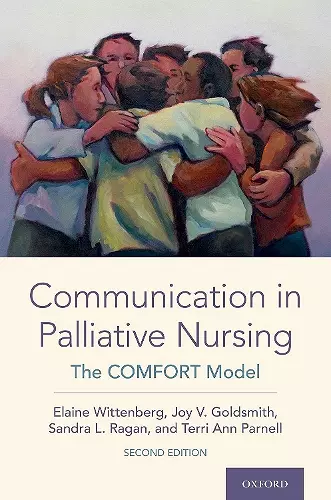Communication in Palliative Nursing
The COMFORT Model
Sandra L Ragan author Elaine Wittenberg author Terri Ann Parnell author Joy V Goldsmith author
Format:Hardback
Publisher:Oxford University Press Inc
Published:10th Mar '20
Currently unavailable, and unfortunately no date known when it will be back

This book presents a model for effective communication in palliative nursing, addressing the complexities of care and the roles of nurses in providing comfort.
In Communication in Palliative Nursing, the authors introduce the COMFORT Model, a comprehensive framework for effective communication in palliative care. This model is built on extensive research conducted over more than ten years, involving patients, families, and healthcare providers. The book emphasizes the importance of connecting with patients and their loved ones, offering options, and making meaning of the experiences faced in palliative care. The revised COMFORT curriculum is structured around key components: Connect, Options, Making Meaning, Family caregivers, Openings, Relating, and Team communication, all designed to enhance the communication skills of nurses in this sensitive field.
The narrative approach to communication presented in the book addresses the complex challenges that nurses encounter while providing care. It encourages them to adopt a universal communication model that aligns with the holistic philosophy of palliative care. This perspective shifts the traditional view of nurses primarily as educators and highlights the multifaceted nature of their roles, especially in times of suffering for patients and families. The second edition of Communication in Palliative Nursing reflects significant changes in the palliative care landscape and underscores the critical role of nurses in navigating these challenges.
Moreover, this volume integrates communication theory and health literacy concepts, offering practical clinical tools and teaching resources. These resources aim to empower nurses to improve their communication skills, ensuring they can provide comfort not only to their patients and families but also to themselves during difficult times. The book serves as a vital resource for enhancing the practice of palliative nursing, fostering a compassionate approach to care.
This book is written by four experts in communication (although it is noted that Parnell is also a nurse). It is written about and for the palliative care scene in the USA, but I think the principles discussed make it relevant elsewhere. If you work in palliative care and wonder whether your communication skills could be improved, or if you teach about communication in palliative care, then this book has a lot to offer. * Roger Woodruff, IAHPC Newsletter *
Every clinical encounter encompasses an exchange of information, emotions and impressions. This book empowers nurses and other clinicians to use each encounter as a therapeutic opportunity. Extensively researched and authoritative, Communication in Palliative Nursing is a trove of resources for educators and investigators seeking to advance patient- and family-centered practice. - Ira Byock, MD, author of Dying Well and The Best Care Possible, Active Emeritus Professor of Medicine, The Geisel School of Medicine at Dartmouth University, Hanover, NH
Wittenberg, Goldsmith, Ragan, and Parnell's updates to Communication in Palliative Nursing truly reflect a down to earth approach for developing the skillful and empathic communication techniques needed for effective palliative and end-of-life care conversations. Changes to the COMFORT Model, such as "Connect" and "Making meaning" underscore the importance of the nurseâs role in bearing witness to patient and family suffering. The text shares poignant examples of how nurses can guide patients and families toward accurately understanding their palliative story, while also helping them to find meaning in their suffering. The authors deftly interweave clinical stories to illustrate communication strategies, providing a realistic "how-to" for nurses to incorporate in their everyday practice. - Mary J. Isaacson, RN, PhD, CHPN, Associate Professor, Graduate Nursing, South Dakota University College of Nursing, Rapid City, SD
It is with great enthusiasm that I read Drs. Wittenberg, Goldsmith, Ragan, and Parnell's new edition of Communication in Palliative Nursing. If we are to have a transformation in the delivery of care, we need to be more intentional and nuanced in our communication. The updates in this second edition resulted from iterative adaptations to our evolving field and have increased its relevancy and broadened its impact. I especially appreciate the bookâs increased attention to exploring the Social Determinants of Health and recognizing how diversity too often equals disparity. We all benefit from a deeper understanding of how to create meaningful relationships with diverse people and this text provides practical skills to help us do so. - Shirley Otis-Green, MSW, MA, ACSW, LCSW, OSW-C, FNAP, Collaborative Caring, Toluca Lake, CA
The evidence-based COMFORT Model provides the necessary framework to guide patient-centered communication along the illness trajectory. The specific tools and exercises offered in this book are so powerful; each will assist the nurse and other interprofessional healthcare providers to navigate complex and crucial conversations that honors patient values and achieves quality outcomes. - Maryjo Prince-Paul, PhD, MSN, RN, FPCN, Associate Professor, Case Western Reserve University, Frances Payne Bolton School of Nursing, Cleveland, OH
While good communication skills remain one of the most important functions that impact nursing care, there are still not many curriculums that focus on those for nurses and their roles, especially in regards to âsharing difficult information.â The COMFORT Model fills that need and is easy to incorporate into clinical education strategies. This new edition of Communication in Palliative Nursing is an enhanced version of the curriculum and the use of the clinical scenarios and enhancements to the models based on clinical application make this a must read for any nurse, not just those in palliative care roles. - Anne M. Kolenic, DNP, APRN, AOCNS, Ambulatory Clinical Nurse Specialist, University Hospitals Seidman Cancer Center, Cleveland, OH
ISBN: 9780190061326
Dimensions: 239mm x 157mm x 33mm
Weight: 590g
328 pages
2nd Revised edition